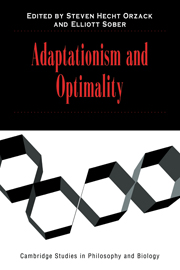Book contents
- Frontmatter
- Contents
- Contributors
- Acknowledgments
- Introduction
- 1 A Likelihood Framework for the Phylogenetic Analysis of Adaptation
- 2 Adaptation, Phylogenetic Inertia, and the Method of Controlled Comparisons
- 3 Optimality and Phylogeny: A Critique of Current Thought
- 4 Fit of Form and Function, Diversity of Life, and Procession of Life as an Evolutionary Game
- 5 Optimality and Evolutionary Stability under Short-Term and Long-Term Selection
- 6 Selective Regime and Fig Wasp Sex Ratios: Toward Sorting Rigor from Pseudo-Rigor in Tests of Adaptation
- 7 Is Optimality Over the Hill? The Fitness Landscapes of Idealized Organisms
- 8 Adaptation, Optimality, and the Meaning of Phenotypic Variation in Natural Populations
- 9 Adaptationism, Optimality Models, and Tests of Adaptive Scenarios
- 10 Adaptation and Development: On the Lack of Common Ground
- 11 Three Kinds of Adaptationism
- 12 Adaptation, Adaptationism, and Optimality
- Index
1 - A Likelihood Framework for the Phylogenetic Analysis of Adaptation
Published online by Cambridge University Press: 06 January 2010
- Frontmatter
- Contents
- Contributors
- Acknowledgments
- Introduction
- 1 A Likelihood Framework for the Phylogenetic Analysis of Adaptation
- 2 Adaptation, Phylogenetic Inertia, and the Method of Controlled Comparisons
- 3 Optimality and Phylogeny: A Critique of Current Thought
- 4 Fit of Form and Function, Diversity of Life, and Procession of Life as an Evolutionary Game
- 5 Optimality and Evolutionary Stability under Short-Term and Long-Term Selection
- 6 Selective Regime and Fig Wasp Sex Ratios: Toward Sorting Rigor from Pseudo-Rigor in Tests of Adaptation
- 7 Is Optimality Over the Hill? The Fitness Landscapes of Idealized Organisms
- 8 Adaptation, Optimality, and the Meaning of Phenotypic Variation in Natural Populations
- 9 Adaptationism, Optimality Models, and Tests of Adaptive Scenarios
- 10 Adaptation and Development: On the Lack of Common Ground
- 11 Three Kinds of Adaptationism
- 12 Adaptation, Adaptationism, and Optimality
- Index
Summary
The common core of all studies of adaptation is the assessment of the role of natural selection in character origin and/or maintenance. A range of information seems pertinent to such studies, including phylogeny, ecology, developmental biology, physiology, biomechanics, ethology, and genetics. At present, however, we lack a conceptual framework for integrating these diverse types of data. Our primary mission in this chapter is to develop one such framework based on likelihood ratios. As we hope to show, this likelihood approach to the study of adaptation not only clarifies the hidden assumptions of adaptationist studies but also provides a common language for communication among disciplines. In particular, we believe that this approach will clarify the interrelationship between studies of uniquely evolved characters and the phylogenetic distribution of analogous variation.
This chapter is not about the definition of adaptation. We happen to prefer a definition of adaptation as characters that evolved via natural selection for some specified biological role (Gould and Vrba 1982; Sober 1984). This historical view challenges us to decipher the causes of the fixation of a particular state in a particular ancestral lineage. As difficult as this might be, we think it is valuable to have a definition of adaptation that encourages such investigations rather than one that leads us to restrict our attention to character function in extant organisms. However, even biologists who prefer an ahistorical definition (e.g., Fisher 1985; Reeve and Sherman 1993) are generally still interested in knowing how and why particular traits evolved. Therefore, regardless of one's favorite definition of adaptation, improved methods for inferring the historical action of natural selection may be welcome. Such methods are the subject of this chapter.
Information
- Type
- Chapter
- Information
- Adaptationism and Optimality , pp. 24 - 44Publisher: Cambridge University PressPrint publication year: 2001
Accessibility standard: Unknown
- 6
- Cited by
